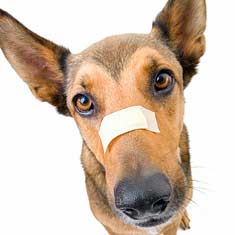TYPES OF CUTS AND WHAT YOU CAN DO TO TREAT THEM
One of the most common accidents is a cut or laceration that causes bleeding. Bandage material, cleaning agents and anticoagulant powder (for nails that have been cut too short) take care of most minor wounds. Larger wounds should be seen by a vet.
TYPES OF CUTS
* When footpads are cut they bleed profusely. First rinse them well with water to remove debris. Scrub the area with iodine soap and flush out the wound with hydrogen peroxide. Then apply antibiotic ointment and a light bandage. Next call your veterinarian.
* Cuts and lacerations in the mouth also bleed a lot because of their large blood supply, but they also heal quickly for the same reason. Flush out mouth lesions with a cool solution of salt water (one tablespoon of salt mixed with one cup of water). Use a turkey baster or large syringe and hold the dog’s head down over a bucket so he doesn’t swallow the solution. Flush the salt solution into mouth several times. On the first and second day feed only broth or make a puree. By the third day most mouth lesions are healed.
WARNING
Avoid tourniquets – they often do more harm than good by blocking circulation to the leg.
WHAT YOU AND YOUR VET CAN DO
* If a dog is bleeding the principle is the same for pets and people. Apply direct pressure to the wound to stop the bleeding. It is best to use gauze or a clean bandage, but anything available – including your hand – will do if necessary. Release the pressure after a couple of minutes.
* If the bleeding stops, access the wound. Use clippers or scissors to remove hair from the area, then take an iodine-type soap and clean up wound. Rinse it out again with hydrogen peroxide. If there is a lot of hair surrounding the wound, before you clip the hair, coat it with water-soluble KY jelly. The hairs will stick to the jelly and not to the wound and will be much easier to wash away. Cover minor wounds with gauze and reassess them the next morning. Always give your vet a call just to be sure.
* If the bleeding doesn’t stop, continue applying direct pressure to the wound while on your way to the vet. For foot wounds, once the dog has been treated by your vet, placing a clean sock over the paw helps keep the dressing clean. Use adhesive tape to secure the sock in place.
* If you think your dog might bite you because he is hurt, scared, and in pain, protect yourself by using a muzzle. A muzzle can easily be made using a rope or belt, your tie, or even a pair of pantyhose. Drape the material over the top of your dog’s nose and then under his jaw, criss-cross it and then bring it back behind his head and tie.
* Homeopathic remedies include Calendula (marigold) 6x: one tablet twice daily until the wound is clearly healing. Arnica decreases bruising, while Hepar sulphuris calcareum 30c can reduce pain and decrease the risk of swelling and infection in the early stages: one pellet every four hours for three doses.
